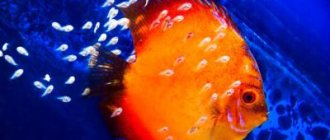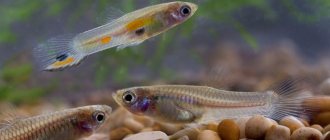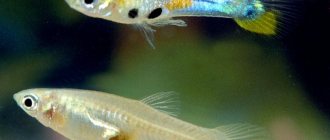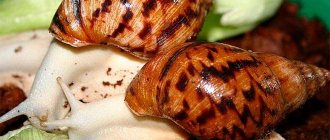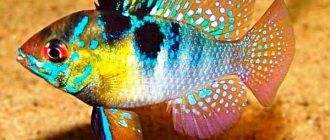Description
In nature, pygocentrus nattereri grows up to 35 cm, in an aquarium up to 25 cm, and lives in large lakes, rivers, small ponds and flooded forests. It lives in flocks of 20–30 individuals; in nature, this tactic simplifies hunting. A group of piranhas can tear their prey to pieces. They attack more often in case of danger. There are species whose average size does not exceed 15 cm.
Appearance
The body is long, laterally flattened. The jaw is convex, there are sharp large teeth. The tail is powerful. The body color is predominantly silver-gray with shimmering dots, and the belly is red. Juveniles are different from adults.
Difficult character
Piranha is dangerous to many other tankmates. Can severely bite an inattentive owner. When kept alone or in pairs in an aquarium, piranhas are timid and react to sudden movements and loud sounds. They feel more confident in a flock of 10 individuals. The group develops a hierarchy, with the dominant individual getting the best pieces of food. There are cases of cannibalism, when a weak and sick individual is eaten.
Lifespan
At home, piranhas live 10–15 years. A record number of 28 years was recorded for the red pacu.
Characteristics of piranha
Piranha belongs to the Characionidae family, the order of Carp-toothed. Inhabits the fresh waters of South America . It has many species and subspecies, the most common and famous of which is the common piranha, also known as the red-bellied piranha.
Piranha cannot boast of outstanding external characteristics - neither large size nor exotic colors. And it would pass for an inconspicuous fish, if not for its reputation, which is confirmed by the structure of its jaws. A large mouth, powerful jaw muscles, razor-sharp teeth with a frank bend back, a protruding lower jaw - a reliable killing weapon and a means of survival in the wild.
This is interesting! Piranha acquires the maximum saturation of its color during puberty. In its natural habitat, the length of a piranha rarely exceeds 30 cm, in an aquarium - 20 cm.
The gregarious way of life of piranhas is due to the tactic of attacking the victim - all en masse. Each one is predatory individually, but together these fish are terrible and merciless. And that’s why it’s so surprising to watch their timid behavior in aquarium conditions. With sudden movements during catching or transportation, this fish instantly lies on the bottom of the aquarium.
Types of piranha
For keeping in aquarium conditions, the common/red-bellied piranha is most often chosen. But the list of aquarium hits includes 6 more species of piranha.
- Lunar/metinnis.
- Dwarf.
- Slim.
- Red herbivorous pacu.
- Flag.
- Mileus redfin/mileus moon.
Species features
- Mileus luna or redfin mileus is a species of herbivorous piranha. He is also one of the most beautiful. Unpretentious in care and maintenance, this species is most suitable for inexperienced aquarists.
- Red pacu grows quickly and can be content with plant foods, with the exception of the spawning period. It is not dangerous because it does not have sharp teeth-blades.
- Metinnis vulgaris or moonfish , or mirror fish, has a reputation as the friendliest piranha.
- Dwarf and flag piranhas are recommended for beginner aquarists, as they are able to withstand minor errors in care and maintenance, and are also not known for increased aggression.
Slender piranha requires a skillful approach and an experienced aquarist.
Return to content
Kinds
The most popular species are the common piranha and the red-bellied piranha. The piranha family has 16 genera and almost 100 species.
Redfin mile
The color of myloplus rubripinnis is silver, the anal fin is bright red, and the tail is translucent. There are varieties with a reddish belly and red-gold spots on the body. In an aquarium it grows up to 15 cm, in nature - up to 25 cm.
Brown pacu
The average size of a pacu is 70 cm, the body is colored in dark, gray and brown tones. The teeth are square, reminiscent of human teeth. Schooling in this species is less pronounced. Suitable for single living.
Red pacu
The red pacu is a herbivorous species, also known as the red-bellied and red-breasted pacu, the two-toothed colossoma, and the vegetarian piranha. The average size in the aquarium is 60 cm. Peaceful and shy fish. It is possible to keep them with many species of comparable size or alone.
Flag
The silvery body is laterally compressed, with a greenish tint on the back. The gill covers have a red spot, the first rays of the fins are elongated and transparent. The tail is forked. The lower jaw is massive. Predatory view.
Slender
The body of the fish is elongated. The color of the scales is silver with a black border on the tail and red on the sides.
Natterera
Natterer's piranha is named after an Australian scientist, known as "saikanga", and the Latin name is Pygocentrus nattereri, a synonym is Serrasalmus nattereri. The body is disc-shaped, reaches 35 cm in length. The color is bright, bluish, the abdomen and fins are bright red, and there is a wide blue stripe on the dark tail.
Lunar Metinnis
These piranhas have a tall body and a light silver color, with a red spot on the gill covers. Herbivorous species. Grows up to 25 cm.
Metinnis silver
The piranha is known as the silver dollar because of its resemblance to a coin. Latin name metynnis argenteus ahl. The size of the silver metinnis is small - 10–15 cm. Males have a veil anal fin, females have a straight one.
Metinnis vulgaris
The abdomen of Metinnis is silvery-white with blue and greenish tints, the fins are transparent. The body is round, strongly flattened laterally. Grows up to 15 cm. Known as mirror fish.
Content
Piranha is an expensive fish; most species require high-quality live food, expensive equipment and a huge aquarium. Not recommended for beginners.
Aquarium
Each individual accounts for at least 120 liters. Place a small group of 4 individuals in a 500-liter aquarium. A school of fish will require a gigantic aquarium with a volume of thousands of liters.
Water parameters
| Temperature | 22–27 degrees |
| Acidity | 6,5–7 |
| Rigidity | 4–15 dGh |
| Water movement | weak or moderate |
It is necessary to maintain a comfortable temperature in the aquarium and monitor the cleanliness of the water. The liquid should not be cold or too warm. The feeding method of predators implies rapid water pollution. Some aquarists change 30–50% of the liquid weekly, others change 10–15% of the total water volume.
Plants
Under natural conditions, the piranha biotope is full of dense vegetation. Fish in an aquarium can damage plants. Place greens that don't require a lot of light:
- Java moss;
- ferns;
- Anubias;
- blue.
Shelters
Provide plenty of hiding places to make timid predators feel comfortable. Leave room for free swimming. Piranhas love shelter in the form of:
- plants;
- caves;
- grottos;
- driftwood
Priming
Place sand or fine gravel at the bottom.
Siphon the soil at least once a week, thoroughly cleaning the entire bottom.
Equipment
Equip your aquarium:
- Filter. Large capacity will require multiple devices. Give preference to an external filter.
- Compressor. The device will provide oxygen saturation of the water.
- Thermometer and heater. Monitor the temperature in the aquarium and maintain it at a level that is comfortable for your pets. In hot weather, a cooler or ice containers placed in water will help cool the water.
Lighting
Choose moderate lighting that suits plants and fish. Too much light causes stress for piranhas. To prevent the appearance of algae, select light in the blue and red spectrum, excluding yellow. Do not allow sunlight to hit the walls of the aquarium. Place the tank at least 1.5 meters from the window. Make sure that the lamp does not overheat the liquid.
Characteristics
Piranhas are predatory freshwater fish native to South America.
Adult specimens grow up to 28 cm. Life expectancy, depending on the species, ranges from 6 to 16 years. Piranhas in an aquarium need company.
The most common aquarium piranhas are the following species:
- common piranha;
- red pacu;
- metinnis lunarum and vulgaris.
These species are calmer in nature than their counterparts living in the natural environment.
Pisces need space to move. For every 2–3 cm of an adult’s body, 7–8 liters of water are needed. Therefore, purchase aquariums of 100 liters or more to keep a school of piranhas. If they do not have enough space, they attack their fellow creatures. It is difficult to get offspring in an aquarium. This requires very soft, acidic water.
Piranhas are school predators. Therefore, get 6–8 individuals at once. Loneliness makes them fearful and shortens their life expectancy.
Place driftwood in the aquarium, make caves and shelters from stones, and plant dense vegetation. Piranhas need places to hide.
Piranhas are temperature sensitive. It should be between 24–28 C. Therefore, purchase a water heater and a thermometer. Long stay in cold or very warm water leads to illness and death. Also provide high-quality filtration and powerful aeration.
Aquarium piranhas have an oblong body. Its length reaches 30–33 cm. The dimensions of some phenotypes are 20 cm. The life cycle reaches 10 years. How long do these species live in natural conditions? The period reaches 15–20 years.
These aquarium fish have a distinctive feature by which even beginners can identify them. This phenotype is distinguished by its massive lower jaw and powerful tail.
The color of adult fish is silver-steel. All fins are colored red.
Piranhas are populated only in species-specific containers. After all, such phenotypes can only get along with their relatives.
In order to identify the leader, aquarists observe behavior. The leader is the first to consume food, choose the best place, and start fights.
An aquarium requires 2-3 fish. One individual requires 150–160 liters. The size of aquarium tanks that are used to house 2–3 piranhas reaches 450–500 liters.
Pre-cleaned and settled liquid is introduced into aquariums that are prepared for piranhas. For these purposes, filtration units with mechanical and biological components are used. With their help, organic residues are removed from water.
The acceptable temperature level in the tank is 26–28 degrees. To maintain this mode, water heaters are used. Among the presented units, experienced aquarists choose models that are supplemented with thermometers and regulators.
In a home aquarium containing Natterera piranha, the following devices and assemblies must be present:
- Powerful filter. Because a piranha aquarium quickly fills with waste and organic debris, a mechanical or biological filtration system is required.
- Water change. Every 7-10 days, 20-25 percent of the water in the container is replaced. If the tank contains 2 individuals, then replacement is performed more often.
- Decorative elements. Driftwood, tunnels, and other accessories are introduced into the container, which the Natterera piranha uses for shelter. Before using decorative parts, they are processed. To do this, use boiling water and special disinfectants.
- Checking aquarium fluid. Every 2-3 days, use special equipment to check the ammonia level. Otherwise, keeping piranhas will become more difficult.
Aerators are introduced into the tanks containing piranhas. With the help of such equipment, the aquarium liquid is saturated with oxygen.
Periodically uses a compressor and siphon. Using such equipment, organic residues, nitrates, etc. are removed. After all, pets do not collect food debris that is dispersed throughout the substrate and decorative elements.
The question of whether piranha can exist with other species of fish sometimes causes the most heated debate among aquarium enthusiasts. Some declare the impossibility of such relationships, others successfully prove the opposite by keeping predators with very small inhabitants. Most likely, it all depends on many factors.
How large is the aquarium reservoir? How much vegetation is there in it? What groups of predatory fish are there, their nature?, how nutritiously they feed and other important factors. It is easiest to keep piranhas with large forms: large locarid catfish. They feel comfortable with piranhas, due to the fact that they live in the bottom layer and do not expose their vulnerable abdomen, and have bone armor that protects them from the teeth of piranhas.
Adult piranhas are quite large fish, growing up to 20-25 cm even in an aquarium.
We suggest you read: What to feed aquarium fish fry
In nature, piranhas live in large schools, so for keeping in an aquarium it is better to immediately purchase at least 8-10 fish.
For a group of ten piranhas about 4 cm in size, an aquarium with a volume of 100-150 liters will be enough for the first time, but it is better to immediately allocate them a more spacious tank, since for several adult piranhas an aquarium of 500 liters will not seem too spacious.
A flock of adult piranhas in an aquarium
To decorate an aquarium with piranhas, you can use various decorative elements: stones, driftwood, live or artificial plants.
But the best solution is a tank densely planted with live plants with open areas for swimming, with dim lighting that matches the needs of the plants. In such conditions, the fish feel more confident, begin to move more actively, demonstrating natural behavior.
Adult piranha in an aquarium
Piranhas are predators, so they are not interested in aquatic vegetation as food.
Piranhas, like many other fish, are characterized by cannibalism, and it is characteristic not only of adults, but also of slightly older fry. Therefore, it is better to purchase juveniles belonging to the same litter, thereby significantly reducing the risk of being eaten by one of them in the near future.
The cause of cannibalism usually lies in overcrowding or lack of food. When fry are densely packed, injuries in the form of bites are inevitable, while some of the injured fish die, while others survive due to their high immunity. Moreover, the wounds heal quite quickly; after several days, only small depressions at the bite sites remind of them.
Aggression is caused by incorrect, from the point of view of the pack, behavior of the prey. It could be a sick or injured fish, and it doesn’t matter if it’s a member of another species or one of the members of its own school.
Despite their reputation as bloodthirsty predators, in captivity, piranhas are highly susceptible to stress and are sometimes very timid. At the slightest danger, the entire flock quickly disappears into the thicket of plants. The fry simply lie on their sides, pretending to be dead.
Therefore, you should not be afraid that one day you will be left without a finger when carrying out periodic work in the aquarium. Piranhas will always stay away from the same scraper or siphon. But we shouldn’t forget about who we are dealing with either; driven into a corner, when caught, a large individual is quite capable of causing injury. But since most aquarists catch fish with a net rather than with their hands, it is the nets that suffer from piranhas first.
If the fish are full, then the first reaction from an object dropped into the aquarium will be a rapid flight. If the piranhas are not fed for a month and they do not eat each other by the end of such an experiment, then any biological object that falls into the water can cause an attack.
What to feed
Feed the animals once a day. A portion of food should be eaten within a couple of minutes, then the piranha will not overeat, and the water will not be contaminated with uneaten food. Provide food commensurate with the jaws of the fish; the piranha ignores food that is too small. Piranhas differ greatly in the type of food they eat. However, occasionally predators need plant nutrition, just as vegetarians sometimes need variety in the form of live food.
Predatory
Feed carnivorous piranha species:
- small aquarium fish;
- squid;
- shrimp;
- beef heart;
- baby frogs;
- little mice.
View this post on Instagram
#piranha #serrasalmus #pygocentrus #monsterfish #acquariologia #pirambeba #predatoryfish #acquascape #predatori
A post shared by “Passione_piranha” (@passione__piranha) on Oct 3, 2021 at 3:16am PDT
Once a week, give predators a fasting day. Make sure that all the inhabitants of the aquarium are well-fed, because in case of malnutrition, mutual oppression or eating of other species will begin. Serve mammalian meat as a supplement to the diet, do not abuse it.
Herbivores
Unlike carnivorous species, herbivores accept dry food. The basis of the diet are:
- zucchini;
- lettuce leaves;
- aquarium plants;
- spinach;
- nettle;
- cucumbers
Feed with tubifex and bloodworms. Animal feed should not exceed 20% of the diet.
Feeding herbivorous piranhas
In addition to predatory species, there are also their herbivorous “analogs,” which are popularly called dollar fish. In this case, the question of what to feed a piranha that does not eat meat requires separate consideration. The diet of vegetarian piranhas may include dry food for large fish with a high content of vegetable protein. These aquarium dwellers are not particularly picky eaters and do well with lettuce, oatmeal, dried dandelions and nettles. However, the best food option is dry food for aquarium herbivorous fish, which can be bought at almost every pet store.
Compatibility
Keep large predatory piranhas in a species aquarium. Despite the aggressive nature, it is possible to live with large catfish such as plecostomus and pterygoplichthys. Small fish will become prey for piranhas. Mix herbivorous peaceful piranhas with comparable species, for example, representatives of the characin family, giant gouramis or shark barbs. Make sure that the water parameters are suitable for different fish.
Reproduction
Piranhas can be bred in an aquarium, but creating the necessary conditions is difficult. The volume of the spawning aquarium starts from 200 liters. During the spawning period, it is necessary to monitor the purity of the water and the stability of parameters. Feed the future parents a high protein animal feed to prepare for spawning.
Sex differences
Sexual maturity occurs at 1.5 years. It is difficult to determine the sex of the fish. Closer to spawning, the males acquire an intense color, and the female’s abdomen becomes rounded from the eggs.
Spawning
Piranhas take care of their young. The fish choose a place to lay eggs and carefully guard the eggs. Depending on the species and individual characteristics of the female, there are 500–15,000 eggs in the clutch. The incubation period lasts 2–15 days. At this time, the male piranha may attack the female, so remove the female.
Fry
Hatched fry grow unevenly, sort the young by size and place larger and smaller piranhas. Starter food: Artemia nauplii, later feed:
- bloodworm;
- daphnia;
- tubifex;
- finely chopped food for adult piranhas;
- granules.
Diseases
Piranhas are hardy and rarely get sick. In poor conditions they are susceptible to:
- poisoning;
- oodiniumosis;
- ichthyophthyriasis;
- “cotton wool disease”;
- tuberculosis.
Effective medications for most diseases can be purchased at a pet store. Before treating fish, read the instructions and determine the causes of the disease. Adjust the conditions: check the water for nitrates and other dangerous compounds, provide the piranhas with a balanced diet and make sure that the water parameters in the home aquarium are suitable for the fish.
Amazonian piranha is a legend in the home aquarium
The common piranha has many different names - red-bellied, red or Natterera. If you apply one of these names to a domestic piranha, you won’t go wrong. The first predators appeared in the aquariums of exotic lovers more than 65 years ago. They were brought to our country in the middle of the last century from the waters of the Amazon and Orinoco.
It is worth noting that the most beautiful appearance of the aquarium piranha becomes at the moment of full puberty. The photo clearly shows the play of colors from the steel back, to the silver body and red belly, throat and anal fin. The red belly reaches about 30 centimeters in length in the wild and 25 in an aquarium. In their natural environment they live in flocks. The minimum number of individuals in one group is 20 tails. They unite to facilitate the search for food. Piranhas are fierce predators, so they choose a prey and attack it in a flock. This species is considered the most ferocious of the inhabitants of the planet's waters.
Content
Despite the fact that piranhas are not difficult to care for and are quite hardy, they are best kept by an experienced aquarist. Don't underestimate her sharp fangs and deadly grip. Inexperienced breeders can get into trouble with her through ignorance and carelessness. Under no circumstances should you place an aquarium with predators low if you have small children.
Piranhas are not suitable for multi-fish aquariums. They prefer, but tragic cases cannot be ruled out there either. If you look closely at the habits, you can find the leader. He is always the first to eat, takes the best places, shows who is boss in the home aquarium, and, most often, is the largest in size. It is not uncommon for fights to occur during clarifications. Aggression and cannibalism are possible. The only option with whom you can try to settle a piranha is a black pacu, provided that the latter has not reached sexual maturity and is considered a teenager.
Reviews
Owners of these interesting fish note that it is fascinating to observe the habits of predators. The intelligence and bewitching appearance of the fish are amazing. Some aquarists have encountered piranhas being aggressive towards neighbors of other species, especially in a small aquarium.
Photo
Adviсe
- If you need to transport fish, use a soft wire net.
- Remember to rinse the filter material once a week with water taken from the aquarium. Tap water is harmful to beneficial bacteria involved in biological filtration of water.
- Place the aquarium only on a special stand made of durable materials. A regular stand will break under the weight of the water tank.
- Clean the aquarium carefully, avoiding sudden movements.
- Choose a glass water thermometer instead of an external one, then you will know the exact water temperature without errors.
Not everyone knows that piranha is a commercial fish that is eaten. Piranha meat contains a large amount of protein and nutrients.
Previous
FishDoctor Garra Rufa Fish
Next
FishContaining cichlazoma bees in an aquarium
Natterer's Piranha or Common Piranha. Keeping Piranhas in a home aquarium.
The Natterer's Piranha (scientific: Pygocentrus nattereri), often called the Common Piranha , Red Piranha , or Red-bellied Piranha , is a notorious fish that is known for its gluttony and meat-eating tendencies. And although these are extremely interesting fish, experts do not recommend them for beginner aquarists. Piranhas, for example, grow into quite large fish, so they need a lot of food (not cheap food!). In addition, you need to care for them very carefully and preferably with some kind of protection (for example, gloves). You should not once again put your hand into an aquarium that contains a school of Red Piranhas, otherwise you risk testing how sharp and strong their teeth are!




